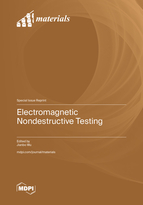Electromagnetic Nondestructive Testing
A special issue of Materials (ISSN 1996-1944). This special issue belongs to the section "Advanced Materials Characterization".
Deadline for manuscript submissions: closed (10 March 2023) | Viewed by 20569
Special Issue Editor
Interests: nondestructive testing and evaluation; sensors; structure health monitoring
Special Issues, Collections and Topics in MDPI journals
Special Issue Information
Dear Colleagues,
Electromagnetic nondestructive testing is of great importance for inductive materials inspection, which has developed rapidly in recent years. New high-accuracy and high-efficiency methods are proposed and developed based on new electromagnetic phenomena, the fusion of multiple methods, new feature extraction methods, and new signal processing methods with artificial intelligence. With the development of electromagnetic nondestructive testing, defect quantification and 3D imaging become possible. The detecting subject has been extended from microstress to a macrodefect, covering the whole course of a failure.
This Special Issue on “Electromagnetic Nondestructive Testing” focuses on a broad range of electromagnetic testing methods, sensors, instrument, signals, and information processing.
Potential topics include but are not limited to the following:
- Eddy current testing;
- Magnetic flux leakage testing;
- Metal magnetic memory testing;
- Electromagnetic acoustic emission testing;
- Magnetic Barkhausen noise testing;
- Eddy current thermography;
- Electromagnetic acoustic transducer;
- Electromagnetic instrumentation;
- Signal and information processing;
- 3D reconstruction and imaging with data fusion;
- Machine learning for signal and image processing;
- Other artificial intelligence applications of signal and information processing.
We encourage contributions from researchers and experts from all related fields in the form of original research works or review articles.
Dr. Jianbo Wu
Guest Editor
Manuscript Submission Information
Manuscripts should be submitted online at www.mdpi.com by registering and logging in to this website. Once you are registered, click here to go to the submission form. Manuscripts can be submitted until the deadline. All submissions that pass pre-check are peer-reviewed. Accepted papers will be published continuously in the journal (as soon as accepted) and will be listed together on the special issue website. Research articles, review articles as well as short communications are invited. For planned papers, a title and short abstract (about 100 words) can be sent to the Editorial Office for announcement on this website.
Submitted manuscripts should not have been published previously, nor be under consideration for publication elsewhere (except conference proceedings papers). All manuscripts are thoroughly refereed through a single-blind peer-review process. A guide for authors and other relevant information for submission of manuscripts is available on the Instructions for Authors page. Materials is an international peer-reviewed open access semimonthly journal published by MDPI.
Please visit the Instructions for Authors page before submitting a manuscript. The Article Processing Charge (APC) for publication in this open access journal is 2600 CHF (Swiss Francs). Submitted papers should be well formatted and use good English. Authors may use MDPI's English editing service prior to publication or during author revisions.
Keywords
- electromagnetic nondestructive testing
- sensor and instrumentation
- signal and information processing
- artificial intelligence
- defect imaging and quantification







